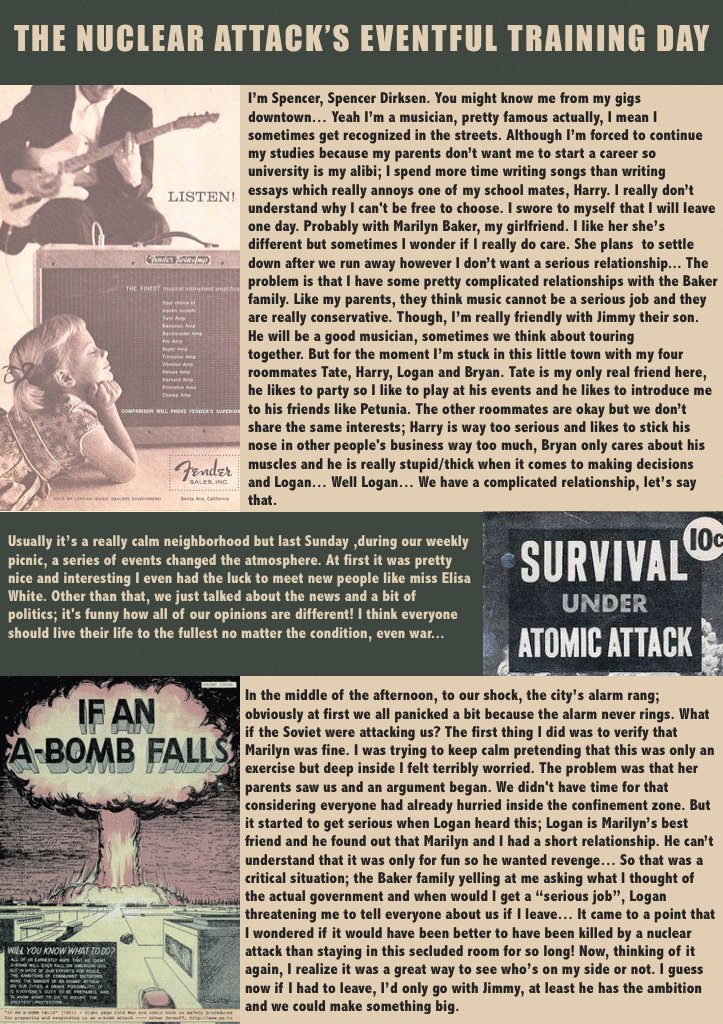"I really enjoyed this experience, because I never did something like that before and I thought that it was a brilliant idea: I had a lot of fun and I practiced my English at the same time, and pretty much everybody was really involved in their roles.
The fact that we had different rooms to play in was also a good thing, it involved us even more in the role-playing.
I had a really good time doing this and I thing this is something that should be made more often in classes." (Joseph, player of John)
The fact that we had different rooms to play in was also a good thing, it involved us even more in the role-playing.
I had a really good time doing this and I thing this is something that should be made more often in classes." (Joseph, player of John)
 |
| Poster by Marie, player of Spencer |

Confinement is an educational Larp about the Cold War, the American society in the 1950s and the balance of Terror. It is designed for a flexible group of players, from 12-36 students. It plays in two hours, with one to two hours of preparation.
The students play as American families and friends in a quiet area of the suburbia. The Archer and the Baker are traditional, over-achieving families. The Bransons are a social-climbing family of African-Americans, and the last group is a fraternity or sorority of students. Each group can feature between 2 and 6 participants, and a few individuals characters are added as extras to make the number of players fully flexible.
As is common with the format, the game is preceded by some preparation time to distribute the character, let the student distribute the roles and create more plot lines between themselves (usually more conflict or romantic subplots). We take time to discuss the time period (which has been studied and researched in class before), and what the perception of the Cold War was to the populations who really lived through it.


The first part of the game took place at a neighbor's gathering on Sunday, where people of the neighborhood just convene to spend some friendly time. At the end of the first part, an alarm rings: it is a bomb alert, they all have to go in confinement. I had converted one of the study rooms into a fake bunker by blocking the windows and bringing some low lights for a better atmosphere
The time inside the bunker was coded through the use of music, siren alarms, and color-coded lights to express different emotional states. After 45 minutes, the bunker would automatically re-open. The derolling discussion focused on the perception of a distant war by civilian populations (in contrast with Graveyard of the Sacrifice, which was more about the actual, living experience of war), and how we can compare fear of the nuclear war then to fear of terrorism today.
The students then had to write a feedback of the experience from their character's point of view. You may read some of the students' stories from the game on the Participatory Storytelling blog.
"I enjoyed this role play because we were more independent than other times; we were in real conditions like in the confinement bunker for example even if it was very hot inside." (Chloe, player of Kate)
**********************
Confinement (enfermement)
est un jeu éducatif sur la Guerre Froide, la société américaine dans les années
1950 et l’équilibre de la Terreur. Il est conçu pour s’adapter à un nombre
flexible de joueurs, de 12 à 36 élèves. Il se joue en 2 heures, avec 2 heures de préparation.
Les joueurs interprètent des
familles américaines ou des groupes d’amis dans une zone tranquille de la
suburbia. Les familles Archer et Baker sont des américains traditionnalistes
friands de réussite. Les Branson sont une famille d’Afro-américains qui ont
réussi à monter à l’échelle sociale, et le dernier groupe est une fraternité ou
sororité étudiante. Chaque groupe peut compter de 2 à 6 participants, et
quelques personnages individuels sont ajoutés pour ajouter à la flexibilité du
nombre de joueurs.
Comme il est de rigueur avec ce
genre de format, le jeu est précédé d’ateliers préparatoires pour distribuer
les personnages, laisser les élèves choisir leur rôle et créer plus d’interactions
entre eux (souvent des conflits ou interactions romantiques). Nous prenons le
temps de discuter de la période (qui a été étudiée et fait l’objet de
recherches en classe au préalable), et ce que représentait la Guerre Froide
pour les populations qui l’ont vécue.
La première partie du jeu a lieu
pendant un rassemblement des voisins un Dimanche, où les voisins se rassemblent
pour un pot amical. A la fin de la première partie, une alarme d’alerte à la
bombe retentit : ils doivent entrer en isolement. J’avais transformé une
des salles d’étude en faux bunker en bloquant les fenêtres et en amenant un
éclairage faible pour rendre compte de l’atmosphère.
Le temps passé dans le bunker
était codifié à l’aide de musique, de signaux d’alarmes, et de changements de
couleur de lumière pour exprimer différentes émotions. Après 45 minutes, le
bunker rouvrait automatiquement. La discussion de sortie de jeu centrait sur la
perception d’un conflit distant par les populations civiles (par opposition au
jeu Graveyard of the Sacrifice qui se concentrait sur l’expérience de la guerre
vécue par les populations), et comment on peut comparer la peur d’une guerre
nucléaire avec la peur du terrorisme de nos jours.
Les élèves devaient ensuite faire
un compte rendu du point de vue de leur personnage, que vous pouvez lire sur la
page dédiée du site Participatory
Storytelling blog.


Aucun commentaire:
Enregistrer un commentaire
Remarque : Seul un membre de ce blog est autorisé à enregistrer un commentaire.